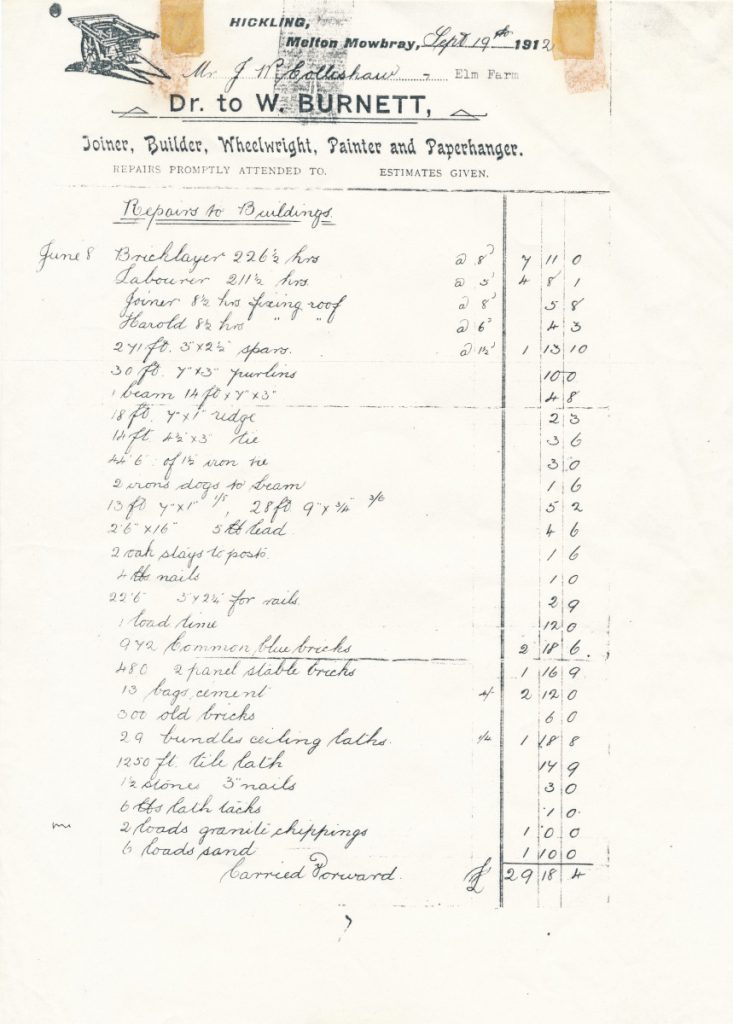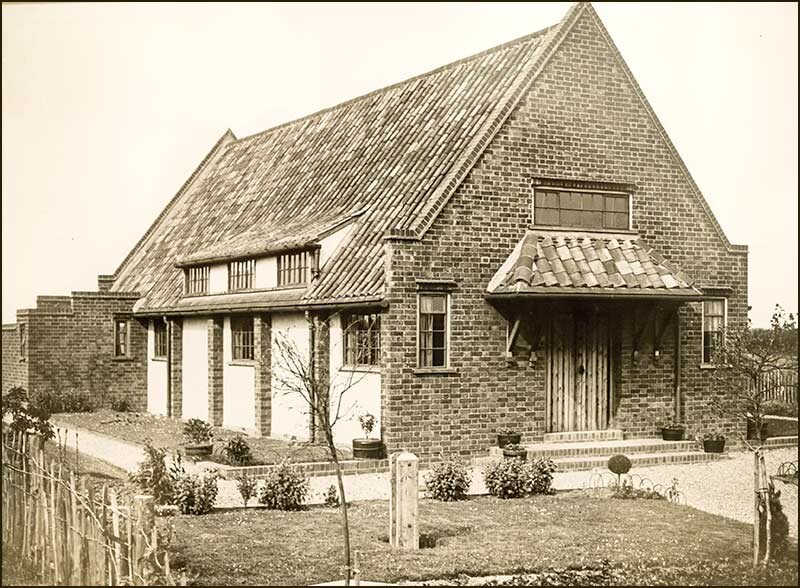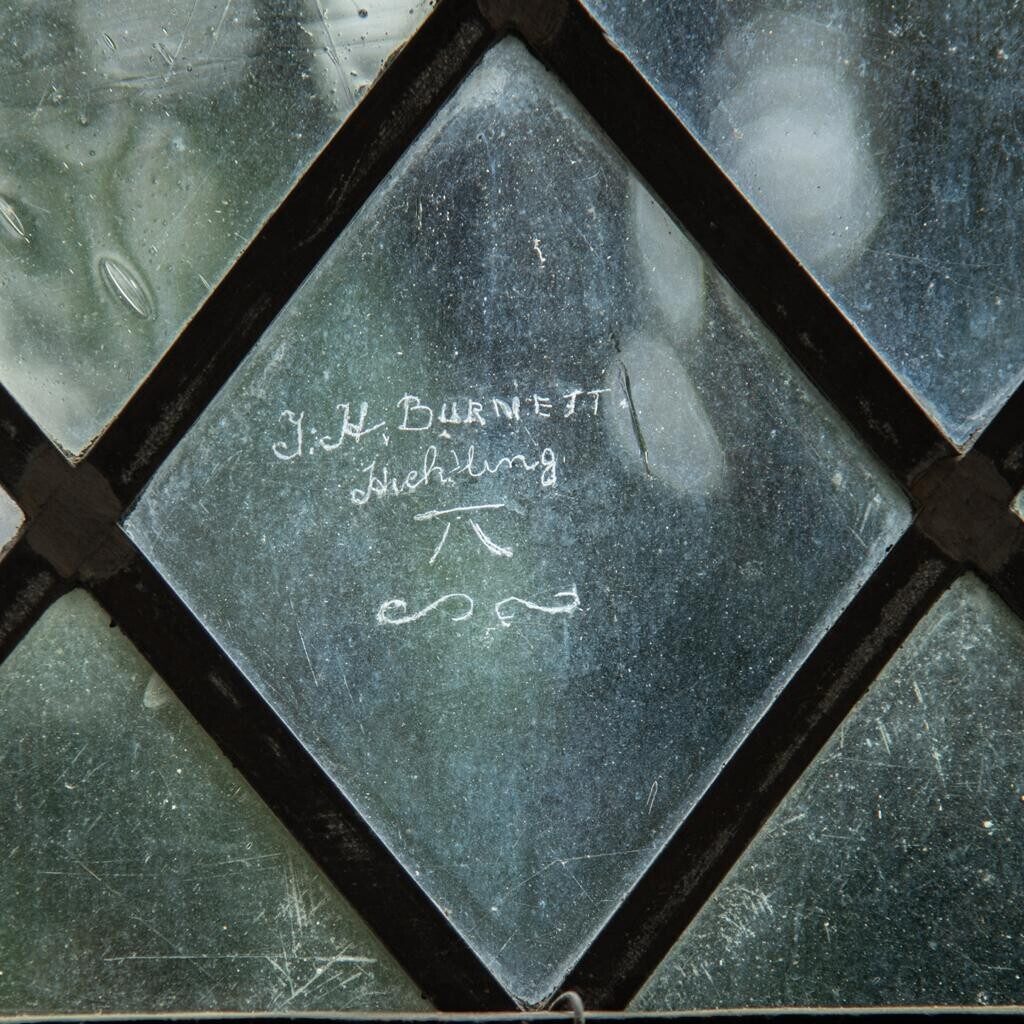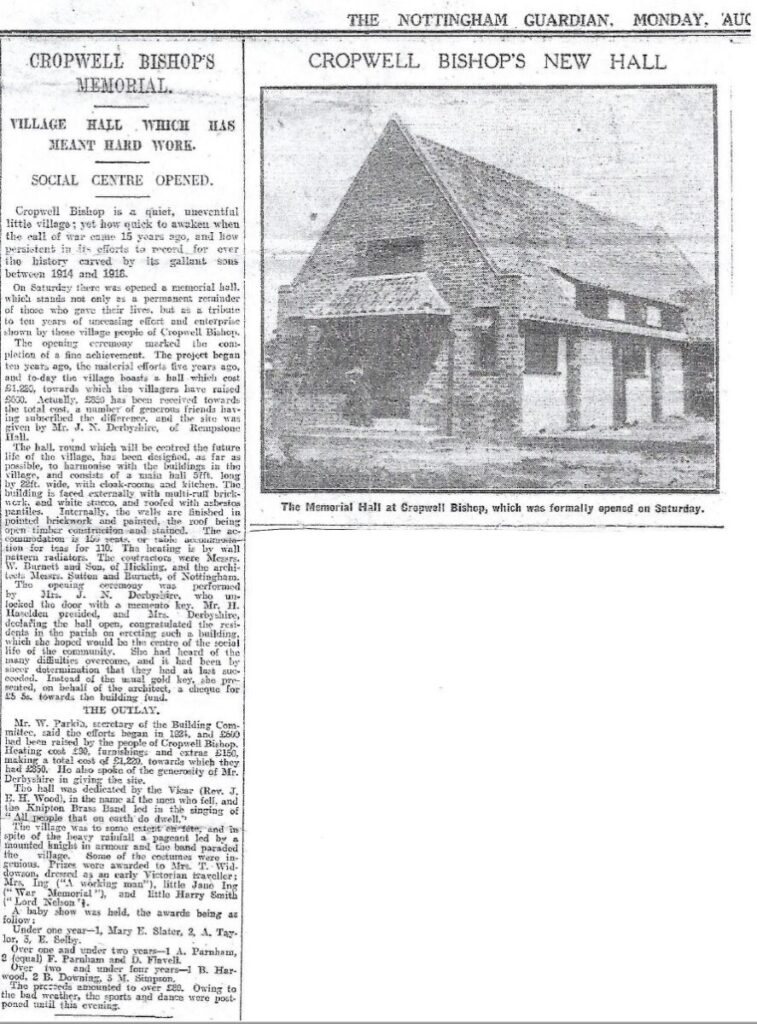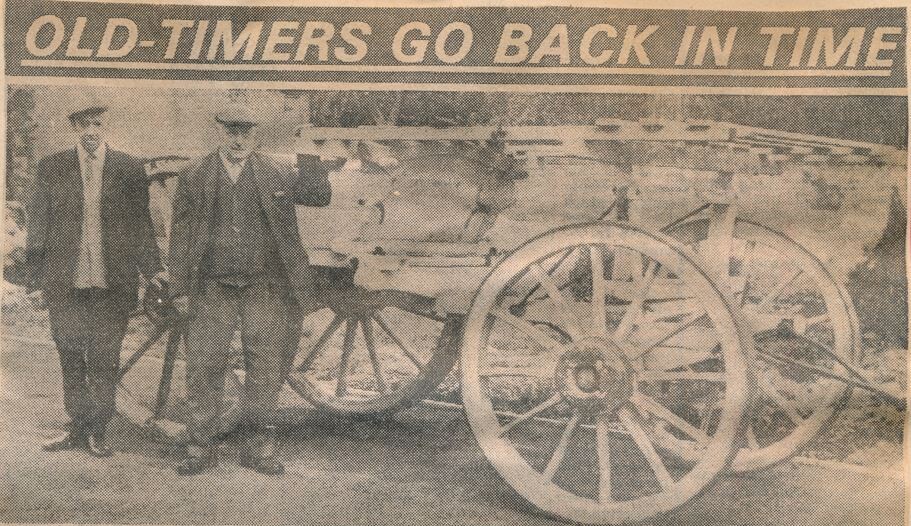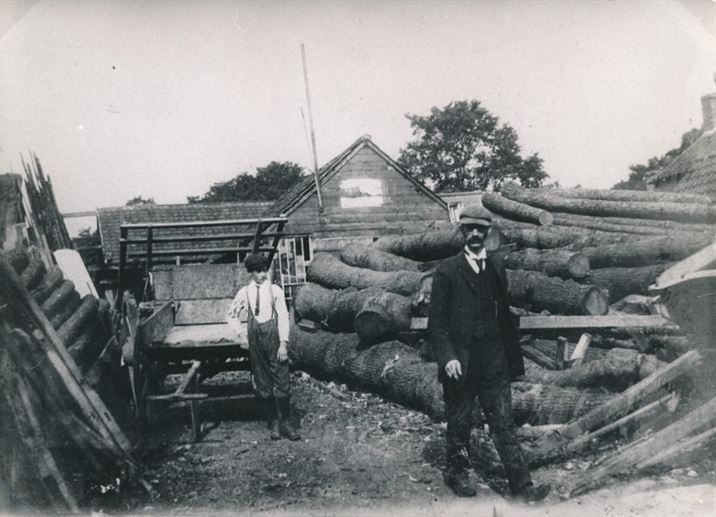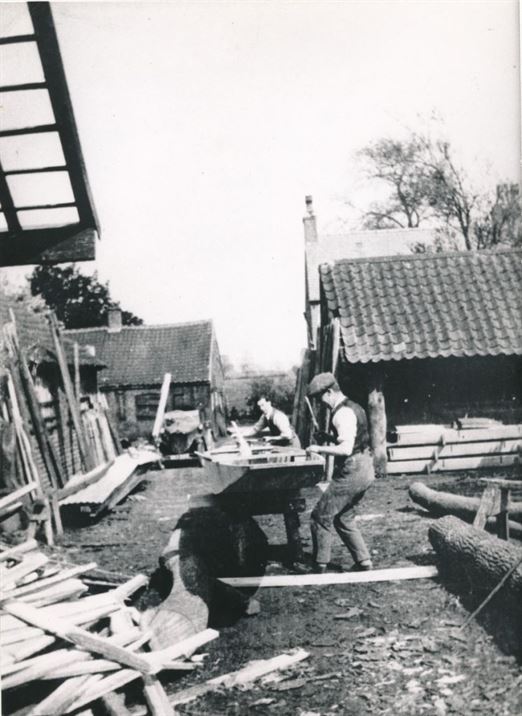Burnetts.
The occupation of joiner and carpenter runs steadily through the Burnett family – often expanded to include; wheelwright, ploughmaker and coffin maker. It is thought that Thomas Burnett (born Hose 1826) set up his business on the corner of Long Lane in Hickling in the 1860s (although it is recorded in the Wadkin archives that he may have come to Hickling in the 1840s) – his was a workshop and a woodyard employing joiners, carpenters and also blacksmiths. In due course, his son William joined the business – expanding operations in to building and the associated professions. His son, Thomas Harold (known as Harold) succeeded him but he was the last to work in the business and the business wound down gradually until he retired in 1958. Harold’s son, Howard, and possible successor had served in the RAF in India during WWII and was left in very poor health and he was unable to continue the family business.
- An invoice surviving from 1912 (repairs to buildings for Mr JW Collishaw at Elm Farm) is headed; W Burnett, joiner, builder, wheelwright, painter and paperhanger (W0026&7).
We are hoping to build a record of the work undertaken by Burnett & Sons including a list of buildings and projects; Please contact us if you can help add to these records.
We know, for example, that Burnetts worked on:
- Waterlane Farmhouse; built by Burnetts, date stone – 1868.
- Hickling Board School; originally built in the 1830s, it was expanded by Burnetts to become a Board School in the 1870s.
- Hickling Chapel woodwork: in October 1899 the new schoolroom attached to the Chapel was opened; “The woodwork of the new building has been executed by Mr Wm Burnett and the brickwork by Mr Geo Squires of Cropwell Bishop.”
- Boulder Causeway/concrete pavement: in 1912, to commemorate the Coronation, W Burnett was the chosen contractor to remove the boulder causeway and lay a concrete pavement from the Plough Inn to the Nether Broughton end of the village – ‘a distance of 1,050 yards or thereabouts’.
- Hickling Chapel War Memorial: designed by Edgar Burnett (first volunteer from hickling to join up) and made by his father, William Burnett (click here).
- “The house named Cesterern was built in 1924 on a plot of land which was formally part of the orchard belonging to Elm Farm. It was built by Burnetts of Hickling for Percy and Beatrice Collishaw. Percy was born in 1893 and he was the son of James and Edith Collishaw of Elm Farm. During WWI Percy joined the army in 1915 and in 1917 he was sent to Eygpt in a troop ship named Cestrian and it was this ship after which the house was named, although spelt Cesterern.”
- Cropwell Bishop Memorial Hall; (insert news article & photo) the Memorial Hall was opened in 1929 – the builders were W Burnett & Sons and the architects, Messrs Sutton & Burnett, Nottm. The total cost was £1,220 and the land had been given by Mr JN Derbyshire who also opened the building. It was dedicated in memory of the men of Cropwell Bishop who were killed in WWI.
An intriguing feature in Church is graffiti engravings in the glass of the east window above the Lady Altar. These span over 100 years and seem to have been made to mark the presence of churchwardens and craftsmen who had worked in the Church. Although undated, this signature is likely to have belonged to Thomas Harold Burnett.
From the Wadkin Archives:
News article transcriptions (Wadkin):
- GRANTHAM JOURNAL – 13th May 1882 ‘Wanted immediately a good wheelwright, accustomed to country work. Apply Thomas Burnett, Hickling’
- GRANTHAM JOURNAL -26 May 1883 ‘Wanted at once, a wheelwright or carpenter and joiner, accustomed to country work – apply Thos. Burnett, Hickling’
- (WNews2 1901-1907 (72)): Apprentice wanted, strong, respectable Youth, indoors – Apply, Thos. BUXTON, Wheelwright, Long Clawson, Melton Mowbray. (Grantham Journal May 18th & 25th 1907)
- NOTES FROM GRANTHAM JOURNAL REPORT -17TH DECEMBER 1921 ‘Death of oldest inhabitant Thomas Burnett. Born Hose, to Hickling aged 21 years, establishing wheelwrights and joiner’s business. In early days in summer at work at 4am and leave off work at bedtime. Used to walk to and from markets carrying his shopping. Trustee Old Friendly Society at Hose and their oldest member. Three times married, 1853, 1866 and 1871, his last wife dying 1904. Commanding appearance and highly respected for integrity and liberality. Retired about 30 years ago. Leaves two sons and two daughters, one son died 1894 [this is an error, it was his daughter Kate who died in 1894], 14 grandchildren, 20 great grandchildren and 2 great great grandchildren living. Funeral Friday week Miss Corner organist’ References in Sunday services at church and chapel
- Nottingham Journal 6th December 1922 ‘in memory of father, Thomas Burnett died 6th December 1921, Annie and Fred’
- (WNews6 1950-1967 (14-21): ‘Village Carpenter’ – article about the Hazlewoods of Asfordby (January 1963)
- (WNews8 1973-1979 (301-2): Old Timers Go Back in Time. Two of the last of the Vale of Belvoir craftsmen met again to see one o the few surviving moffreys returned to the old wheelwright’s and blacksmith’s shop where they made it many years ago. The buildings included a saw-mill and paintshop so that the newly-felled trees brought in by their own timber drugs, eventually left as the finished vehicle or implement. The word moffrey derives from hermaphrodite, meaning having the characteristics of both sexes, for the vehicle used with four wheels and raves and gormers to contain the harvest loads of hay or straw is a farm wagon, but by the simple removal of a coupling, the front axle and wheels can be removed to leave the rear as a complete farm cart for everyday use. Mr Harry Trayford, 85, right, of Nether Broughton and Mr Slater Shelton, 75, of Old Dalby, also pictured, made this moffrey when they worked for the now defunct firm of Burnetts, of Hickling. Mr Trayford, born at Saltby, learned his craft at Upper Broughton. His terms of service for a five years apprenticeship were that he paid 50s to start and 50s at mid-term, and in return received his training and full board, but no wages. When in 1913 he went to Burnetts, Hickling, fully trained and 20 years old, his wage for a 52-hour week was 25s, and a new moffrey cost about £20. Mr Slater Shelton, 75, still plies his craft in the mornings for Mr Spence, shoeing-smith of Hose, making shoes for thoroughbred hunters to follow the Belvoir and Quorn Hunts. (December 1978) (Mrs Wadkin notes that Slater Shelton was age 71, not 75)
Wadkin books.
Scrapbook of Hickling:
- (p.22) census occupations: Joiner (1851) 4 (1861) 3 (1871) 5; Bricklayer – 2,2,1; Blacksmith – 1,3,5; Carpenter – 1,1,3; Prospector of Houses – 1 (1861); Wheelwright – 2 (1871).
- (p.43) Woodyard Mr. W. Burnett owned the woodyard and had horse drawn timber drugs. Tree trunks would be sawn by a steam driven engine. His business also employed joiners, builders, painters and decorators, a wheelwright, undertakers and blacksmiths. He lived in the house on the corner of Long Lane and part of his yard can be seen on the extreme right of the photograph of ‘The Homestead’.
- (p.45) Blacksmith Mr. Alwyn Shelton was at one time the blacksmith with the W. Burnett firm. The building still stands and runs along the path side just south of Long Lane. During the 1920’s Mr. Shelton built himself a shop on a piece of land opposite the Manor gate. In May 1966 the shop and orchard in which it stands, the plot being approximately 1,175 sq. yds. was offered for sale at a price of £1,100. It was bought by the builders Hills and Little of Cropwell and converted to a bungalow. At the present time ‘The Old Forge’ is owned and occupied by Mr. and Mrs. D. Sallis. There was at one time another forge opposite the ‘Little Green’ the building end on to the road which has a large brick horseshoe built into the wall (next to the post box). The house is now called ‘ Forge Cottage’ and is owned and occupied by Mr. and Mrs. M. Turner.
- (p.48) 1912 Village Improvement The old boulder causeway is to be removed and a new concrete one laid to extend from the ‘Plough Inn’ to the end of the village a length of 1,050 yards thereabouts. Contractor for the work Mr. W. Burnett, cost £100. Work to commemorate the coronation of George V.
- (p.48) Shire horses The shire horses were a wonderful sight to be seen working in the fields or pulling the timber drugs belonging to Mr. Burnett.
- (p.56) Methodism arrived in Hickling in 1799 and services were held in private houses. The first chapel was a small comfortable building built in 1804 at a cost of £150 largely given by residents. The present day chapel replaced this in 1848 and when land became available at the back a schoolroom was added in celebration of the 50th anniversary in 1899. In later years the porch was moved from the side of the building to the front facing the road. During 1909 an estimate was given by Mr. Burnett for replacing the seats in the chapel with modern ones at a cost of £170- £180.
- (p.71) Minutes 11th March,1875. It was agreed to accept Mr. Burnetts contract for altering and fitting up the school and fencing around but he was requested to specify more particularly what was to be done. It was also agreed that the clerk should make application to the Educational Department for the borrowing of £300 to complete the work.
- (p.72) Minutes 7th February,1876. It was unanimously resolved to accept Mr. Burnett’s tender for enlarging and completing the school subject to approval of Education Department ••••• £442 fittings etc. to be £30 extra.
- (p.91) Lot 6. 5 Cottages situated at the back of the Council School, out-offices, gardens, orchard adjoining, 2 in occupation of Messrs. Jeffrey (chimney sweep) and Lester the remaining unoccupied. Bought by Mr. Wm. Burnett for £245. Now owned by Mr. H. Hartshorn.
- (p.94) September, 1925. “To be sold by Auction at ‘The Plough Inn’ at 6 p.m. prompt. Dwelling house in Main Street in the occupation of Mr. T.Stubbs. Dairy, scullery, kitchen, 2 large front rooms, 4 bedrooms and attic. One of the front rooms was formally the village post office. Also two brick and slated cottages with good gardens at the rear of the above in the occupation of Messrs. Squires and Daft”. Bought by Mr. W. Burnett for £440.
- (p.98) September 1929 A grass paddock in centre of village purchased for £140 on behalf of the local branch of the British Legion. (The Dovecote) sold during the 1960’s to Hills and Little (Builders) who built the two bungalows, building permission was not granted to build at the back.
- (p.98) February 1906 Offered for sale by Auction at ‘The Plough Inn’ two brick and tiled cottages with gardens and outbuildings in the centre of the village in the respective occupation of Mr. Thos. Brewin and Mrs. Lamb together with two old cottages. The whole containing an area of 580 sq. yds. Bought by Mr. W. Burnett of Hickling for £150. (1980 only April Cottage owned and occupied by Mr. & Mrs. Grove still standing).
- (p.98) July 1908 To be sold by Auction at ‘The Wheel Inn’ all that piece of Freehold Grass Land situate at Hickling known as ‘Benson Wong Close’ comprising 4a 1r 35p or thereabouts now in occupation of Mrs. Eliza Parkffiat a yearly rent of £15 . Sold to Mr. Burnett for £65 an acre.
Reflections of Yesteryear:
- (p.3) Photo Bridge House 1914 – 1918 Dora Collyer, Winnie Collyer, Annie Marson, Crutchy, Elsie Copley, Arch Copley. The heap of gravel belonged to Burnetts and would have been brought along the canal by barge.
- (p.57) 1928 Diamond wedding of Mr & Mrs Thomas Nixon Mr. & Mrs. Nixon lived down The Green in one of the cottages now occupied by Mr. H. Hartshorn. Mr. Nixon was a chimney sweep, who as a child climbed up inside the chimneys. In adult life Mr. Nixon became a heavy drinker. One night when Mr. Nixon was in ‘The Plough’ someone took his pony and trap, put the shafts through a fence and the pony back in. On another occasion Mr. Nixon was found lying in the churchyard at Long Clawson. He was told ‘come on Mr. Nixon, you can’t stay here all night’ to which he replied ‘move some of those other •****•’s they’ve been here longer than me’. Mrs. Nixon died aged 77 years and her husband 86 years. Their son Billy was a waggoner at Burnetts and later in his life, during the 1940’s, the school caretaker. On wet mornings he would not let the children in school until 9 a.m. on account of their feet paddling on his clean floor. Mr. Billy Nixon lived in the roadside cottage of what is now one house, ‘White Cottage ‘ on Clawson Lane.
- (p.76) Thomas Burnett, son of Thomas, was born in 1826. He came from Sheffield to Hose and walked daily to Hickling where he started his business. A gentleman from Hose ordered a plough to be made by Mr. Burnett. On the completion of the work Mr. Burnett (a very tall man) carried the plough on his shoulders to the customer at Hose. Each Saturday he walked to Nottingham to visit the bank and also purchase the weeks groceries which he carried home in a large basket. Thomas was married three times, in 1853, 1866 and 1871. He would have then married Miss Chamber lain who lived in Yew Tree House but she wouldn’t agree to this. Thomas’s son William, born in 1861, joined the business and later his son Thomas Harold, born in 1891 followed. On the death of his grandfather Thomas in 1921 aged 95 years, Harold moved from his home at the corner of Mill Lane to the house on the business premises at the corner of Long Lane. (Note: this is the only reference found to Sheffield and there is no source available for this information – further checks needed.)
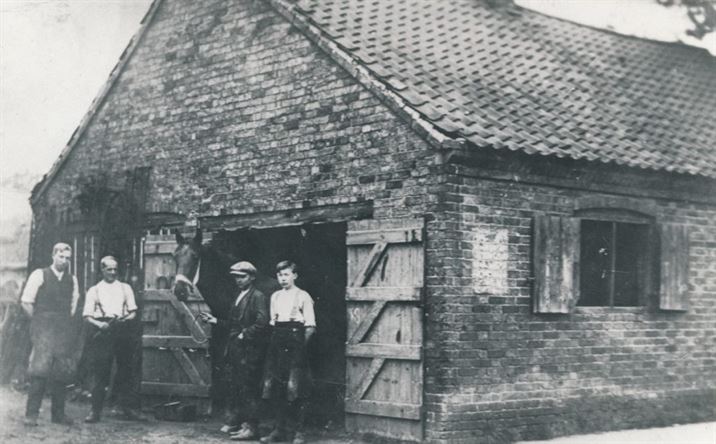
Maggie’s Memories:
- (p.18) Many trees during the war 1914-18 were sawn down and W. Burnett of Hickling would buy them, but the “tree tops” would be sold to anyone for 10/- or even less, no one in those days need ever be short of wood for their fire.
- (p.31) The Highlight of the Sunday School was most certainly the Sunday School Anniversary and always held on the last Sunday in June (which traditionally was Hickling Feast weekend) I don’t know officially how old the anniversary platform is, but was in use before I went to school and is still used and in as good condition, the platform was made by the local joiner at the firm of Burnett & Son, and sadly no longer in existence, it is stored in the loft over the Classroom.
- (p.45) When I was a girl Hickling had almost all their own tradesmen, W. Bumett & Son, I also remember W. Burnetts father a devoted Methodist and attended service until a great age, the Firm of Burnett were Joiners. Builders. Painters and Decorators Wheelwright. Blacksmith. Woodmen. and Undertakers and has been folded up a number of years, a great pity.
- (p.45) BRICKLAYER Mr. Jack Squires
- (p.46) BLACKSMITHS The first blacksmiths shop I recall was Mr. Alwyn Sheltons and situated on the Main St. with the W. Burnett Firm, until recently was used as garage by Mr. Norman Marriott. Mr. Shelton after awhile built a new Shop in an orchard still on the main street and worked there until ill health forced him to retire. We school children were fascinated seeing something new being built and would stop to watch for just a short time whenever we passed. We also loved watching the horses being shod, and two Hickling boys were taught this trade but did not continue, they were Harold Marson or Cox, he did not work as a blacksmith until after he married, and the other Wilfred Parr, they have both now passed away. After Mr. Shelton died the Forge was sold and made into such a lovely Bungalow and called ‘The Old Forge’. Before my time there was yet another Forge and the Blacksmiths shop and that is now used as a garage it is now called ‘Forge Cottage’ and is opposite the Village Hall.
- (p.47) Another fascinating craft of long ago was THE WHEELRIGHT. The shop was next to the Burnett forge and is still to be seen but so dilapidated, let’s hope one day someone will build something decent to look at, we kids would crowd round the window until we were a nuisance. Mr. Harry Trayford of Nether Broughton was the one wheelwright I remember working in this shop, and Mr. Bert East was a joiner there, he was from Cropwell Bishop. We children used to love watching when the men were ‘Hooping’ that was fixing hoops on cart wheels, the fire for hooping would be lit outside the blacksmiths shop and it was a fascinating process, no doubt this craft has gone mores the pity. Mr. Trayford now over 80 still cycles from Nether Broughton in the summer, as he remarked “To see what Hickling has been up to”
- (p.47) WOODMEN Often early in the morning’s one would hear the heavy horses pulling the long “trugg” (from W. Burnetts wood yard) going to collect the felled trees all around Hickling, the tree trunks would be piled on to the trug and the horses would pull the heavy load back to the wood yard, when needed they would be sawn by a steam driven engine and saw, the noise could be heard over the whole village. We kids loved to watch, if we had the chance, the men working the saw always seeing we stood well back. One of the trug men was Mr. Willie Nixon (Nicko) every one called him) he lived in a cottage in Clawson Lane, in fact there were two cottages and have now been modernised and made into one house, (Mr. & Mrs. Wilcox living last their). Mr. Nixon loved his horses and although being fond of drink he never missed last thing at night to ‘Supper Up’ he talked to his horses as though they were children. On Christmas Eve he always requested the Carol Singers to sing the tune ‘Sovereignity’ to the words ‘Would Jesus have the sinner die’ and he would put one shilling 1/- (5p in this money), and from his wages was a good contribution. Another man with the trugg was Mr. Charlie Munks (his Grandson still lives in Hickling), we children dare not say much to him, but he was a good skater, when the canal was frozen it was always Charlie Munks who made the figure eight 8 on the basin, and it always looked so easy to we kids watching. The strength of the horses when pulling sometimes a double trugg over the Canal bridge was marvellous, now the bridge has gone and the horses, and all we see are lorries piled high.
- (p.89) Mr. & Mrs. George Squires. Lived in Chapel Lane (now Bridegate) in the house where Mr. Temperton lives. He had a family of two sons, Mr. Squires was a bricklayer and worked for the firm of Wm. Burnett, he was a member of the Methodist Church Choir. Loved children. At all social evenings George Squires would at the close of the proceedings go to the centre of the room and stand on his head, and he was bald on top. One August Bank Holiday Monday, the Canal Basin was packed with fishermen and lots of people around watching, when Mr. George Squires and friends were out walking, and he decided to climb on the bridge parapet and stand on his head, every one gasped. Mrs. Squires was a big jolly woman, but suffered a great deal in later years before she died. After a few years Mr. Squires married again to Miss Jessie Burton and lived down the Green until he died. The last of the family, the youngest son Arch died 1974.
- (p.89) Mr. & Mrs. J. Squires Also a bricklayer, with own business, was brother to George and lived at Canal View, where his daughter Hilda and Husband still live. Mrs. Squires was daughter of Mr. & Mrs. Robert Parr, she was tall and her husband short, they had five daughters, Gladys, Olive, Miriam, Hilda, Evelyn, the two youngest left. Mr. Squires served in the 1914-18 War and was a staunch member of the British Legion, and Mrs. Squires was a founder member of the Women’s Section.
- (p.93) Burnett family The firm of Burnett in Hickling I remember all my life, until the business ended. Builders, Bricklayers, P. & Decorators, Undertakers etc. Mr. T. Burnett I remember first, old man with white hair and very deaf, Methodists. William Burnett his son, married a Woolley, they had a family of Edith, in her 80’s and in old peoples home at Radcliffe. Harold over 80 in Darlington with Daughter, Edgar and Horace both died. All the family suffered from deafness. No Burnetts left in Hickling today.

